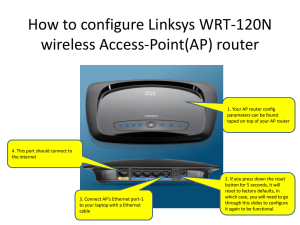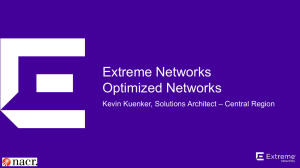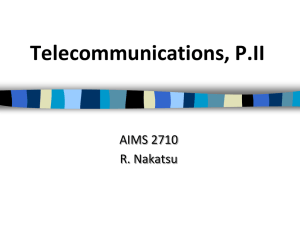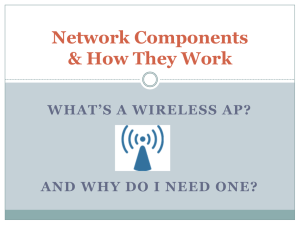Chapter 5 - James Dang
advertisement
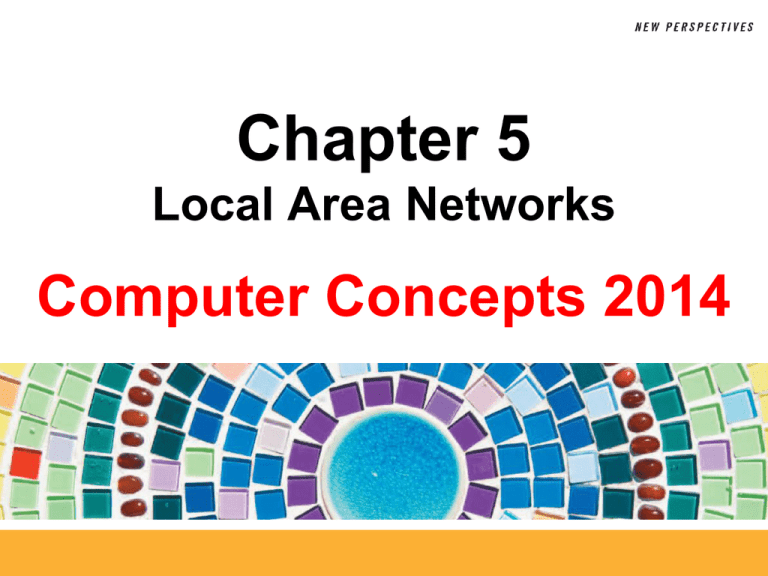
Chapter 5 Local Area Networks Computer Concepts 2014 5 Chapter Contents Section A: Network Building Blocks Section B: Wired and Wireless Technologies Section C: Network Setup Section D: Sharing Files Section E: Wireless Security Chapter 5: Local Area Networks 2 5 FastPoll True/False Questions Answer A for True and B for False 050100 The networks typically installed by individuals in homes are classified as LANs. 050200 High bandwidth networks, such as cable TV and DSL are referred to as broadband. 050300 When you send an e-mail message over a network, it is chopped up into packets. 050400 The IP address assigned to your computer on the Internet is derived from your computer’s MAC address. 050500 Wired network connections can offer higher speeds than wireless connections. Chapter 5: Local Area Networks 3 5 FastPoll True/False Questions Answer A for True and B for False 050600 The most popular type of wired connection is Ethernet. 050700 Network speeds are measured in megabytes and gigabytes. 050800 Many wireless connections use radio waves to transmit data. 050900 Bluetooth is a wireless technology used for WANs. Chapter 5: Local Area Networks 4 5 FastPoll True/False Questions Answer A for True and B for False 051000 A wireless infrastructure network uses a centralized broadcasting device, such as a wireless access point or router. 051100 Wireless connections are less secure than wired networks. 051200 A hub can be used to extend a network by adding additional wired devices. 051300 To configure a router, you usually have to start a browser and enter the router’s IP address. Chapter 5: Local Area Networks 5 5 FastPoll True/False Questions Answer A for True and B for False 051400 A homegroup is a temporary network of handheld computers. 051500 Public key encryption uses a public key to encrypt messages, but a private key is required to decrypt messages. Chapter 5: Local Area Networks 6 5 Section A: Network Building Blocks Network Classifications LAN Advantages and Disadvantages Network Devices Network Links Communications Protocols Chapter 5: Local Area Networks 7 5 Question 052100 Networks come in many sizes and use many different technologies, yet they all need to communicate with each other. What is the key to network intercommunication? A. Circuit switching B. Network protocols C. Network topology D. Peer-to-peer technology Chapter 5: Local Area Networks 8 5 Network Classifications Personal Area Network (PAN) – interconnection of personal digital devices or consumer electronics Local Area Network (LAN) – connects computers in a limited geographical area Metropolitan Area Network (MAN) – public highspeed network with range of about 50 miles Wide Area Network (WAN) – covers a large geographical area and typically consists of several smaller networks Chapter 5: Local Area Networks 9 5 LAN Advantages and Disadvantages LANs enable people to work together Sharing networked software can reduce costs Sharing data on a LAN can increase productivity Sharing networked hardware can reduce costs Sharing an Internet connection can be cost-effective and convenient Sharing networked hardware can provide access to a wide range of services and specialized peripheral devices Chapter 5: Local Area Networks 10 5 LAN Advantages and Disadvantages One disadvantage of LANs is that when a network malfunctions, all the resources you’re accustomed to accessing are unavailable until the network is repaired LANs are vulnerable to unauthorized access LANs are vulnerable to malicious code Chapter 5: Local Area Networks 11 5 Network Devices Each connection point on a network is a node To connect to a LAN, a computer requires network circuitry, sometimes referred to as a network interface card (NIC) A networked peripheral, or network-enabled peripheral, is any device that contains network circuitry to directly connect to a network A storage device that directly connects to a network is called network attached storage (NAS) A network device, or network appliance, is any electronic device that broadcasts network data, boosts signals, or routes data to its destination Chapter 5: Local Area Networks 12 5 Network Devices Chapter 5: Local Area Networks 13 5 Network Links A communications channel, or link, is a physical path or frequency for signal transmissions Bandwidth is the transmission capacity of a communications channel Broadband Narrowband Chapter 5: Local Area Networks 14 5 Communications Protocols Rules for efficiently transmitting data from one network node to another: Divide messages into packets Affix addresses to packets Initiate transmission Regulate flow of data Check for transmission errors Acknowledge receipt of transmitted data Chapter 5: Local Area Networks 15 5 Communications Protocols A packet is a “parcel” of data that is sent across a computer network Circuit-switching technology vs. packet switching technology Chapter 5: Local Area Networks 16 5 Communications Protocols Every packet that travels over a network includes the address of its destination device A MAC address is a unique number assigned to a network interface card when it is manufactured An IP address is a series of numbers used to identify a network device IP addresses can be obtained through DHCP Chapter 5: Local Area Networks 17 5 Section B: Wired and Wireless Technologies Wired Basics Ethernet Wireless Basics Bluetooth Wi-Fi Chapter 5: Local Area Networks 18 5 Question 052200 Suppose your friend has a home office and usually does most work on a desktop computer. Your friend also has a smartphone and tablet computer that could benefit from Internet access. What kind of network would you recommend? A. A network that has a wireless router that provides wireless and wired connections as well as Internet access B. A cloud network that can be accessed from a bridge device C. A file server D. A 100 gigabit Ethernet network Chapter 5: Local Area Networks 19 5 Wired Basics A wired network uses cables to connect network devices Wired networks are fast, secure, and simple to configure Wired connections are more secure than their wireless counterparts Devices tethered to cables have limited mobility Chapter 5: Local Area Networks 20 5 Ethernet Ethernet is a wired network technology that is defined by IEEE 802.3 standards Simultaneously broadcasts data packets to all network devices Vary in speed from 10Mbps to 100Gbps Chapter 5: Local Area Networks 21 5 Ethernet Chapter 5: Local Area Networks 22 5 Wireless Basics Wireless network technology transports data from one device to another without cables or wires RF signals Transceiver Microwaves Infrared light Slower than wired networks Security concerns Chapter 5: Local Area Networks 23 5 Bluetooth Bluetooth is a short-range, wireless network technology designed to make its own connections between two devices Chapter 5: Local Area Networks 24 5 Wi-Fi Wi-Fi refers to a set of wireless networking technologies defined by IEEE 802.11 standards Wireless ad-hoc protocol Wireless infrastructure protocol Chapter 5: Local Area Networks 25 5 Wi-Fi Chapter 5: Local Area Networks 26 5 Section C: Network Setup Setup Overview Router Installation Router Configuration Internet Connection Device Connection Chapter 5: Local Area Networks 27 5 Question 052300 When you’re setting up a wireless network, you see an option asking if you want to broadcast the network SSID. You should: A. Change the default SSID and broadcast it. B. Turn SSID broadcasting off so that hackers don’t know the network’s encryption key. C. Make sure SSID is broadcasting so that your network is protected by strong encryption. D. Activate SSID broadcasting or else the network devices won’t be able to send data to the router. Chapter 5: Local Area Networks 28 5 Setup Overview Plug in the router Connect the router to a computer Configure the router Access the router setup utility Create a new router password Chapter 5: Local Area Networks 29 5 Setup Overview Enter an SSID for the network Activate WEP, WPA, or PSK and create an encryption key Connect an Internet access device Set up the wireless workstations Chapter 5: Local Area Networks 30 5 Router Installation Look for a Wireless-N router that includes a Gigabit Ethernet switch Wired and wireless connections Make sure the number of Ethernet ports is sufficient for the number of wired devices that you intend to connect Chapter 5: Local Area Networks 31 5 Router Installation Chapter 5: Local Area Networks 32 5 Router Configuration Before using your network, you should adjust the router’s configuration settings to make sure your network is secure Stored in router’s EEPROM You must connect a computer to the router You can use your computer’s browser to access the router configuration utility Chapter 5: Local Area Networks 33 5 Router Configuration Chapter 5: Local Area Networks 34 5 Router Configuration An SSID (service set identifier) is the name of a wireless network Use the router configuration software to change the default SSID Chapter 5: Local Area Networks 35 5 Router Configuration Each workstation requires a unique address for sending and receiving data Chapter 5: Local Area Networks 36 5 Router Configuration Wireless encryption scrambles the data transmitted between wireless devices and then unscrambles the data only on devices that have a valid encryption key WEP WPA PSK Chapter 5: Local Area Networks 37 5 Internet Connection Your Internet service provider supplies a device called a modem that is designed to carry data to and from the Internet This device typically has a standard Ethernet port that can be connected to a router Most routers supply a WAN port designed for an Internet connection Plug a standard network cable into the router’s WAN port and connect the other end of the cable into the Internet modem Chapter 5: Local Area Networks 38 5 Internet Connection Chapter 5: Local Area Networks 39 5 Device Connection Simply turn on any Windows computer with wireless capability and make sure that it is in range of your router Chapter 5: Local Area Networks 40 5 Device Connection Macs automatically sense available networks and give you the option of connecting to them Chapter 5: Local Area Networks 41 5 Device Connection Any device that has Wi-Fi capability should be able to connect to your network Chapter 5: Local Area Networks 42 5 Device Connection Chapter 5: Local Area Networks 43 5 Section D: Sharing Files File Sharing Basics Accessing Shared Files Sharing Your Files File Servers Network Troubleshooting Chapter 5: Local Area Networks 44 5 Question 052400 There are many ways to share files among the computers on a network. Which one of the following is the LEAST secure way to share files? A. Use a file server. B. Activate file sharing for the root directory of all the computers in the network. C. Designate specific folders on your computer as shared. D. Put files you want to share in the Public folder. Chapter 5: Local Area Networks 45 5 File Sharing Basics File sharing allows files containing documents, photos, music, and other data to be accessed from computers other than the one on which they are stored Once your network gives you access to other computers on the network, you can view a list of files stored there Chapter 5: Local Area Networks 46 5 Accessing Shared Files To see a list of devices on your network, you can use your operating system’s file management utility Network discovery is a setting that affects whether your computer can see other computers on a network, and whether your computer can be seen by others Chapter 5: Local Area Networks 47 5 Accessing Shared Files Chapter 5: Local Area Networks 48 5 Sharing Your Files Chapter 5: Local Area Networks 49 5 Sharing Your Files When you activate file sharing, files in Public folders can be accessed by other network users You also can make specific files shareable If you want the convenience of sharing files, limit what you share and who you share it with: Assign permissions to files Limit sharing to specific people Remove sharing from files you no longer want to share Use a homegroup if your network is composed of Windows computers A homegroup is a collection of trusted Windows computers that automatically share files and folders Chapter 5: Local Area Networks 50 5 Sharing Your Files Chapter 5: Local Area Networks 51 5 Sharing Your Files Chapter 5: Local Area Networks 52 5 File Servers A file server is a computer whose primary purpose is to be a repository for files that can be accessed by network workstations Chapter 5: Local Area Networks 53 5 Network Troubleshooting Network problems can stem from a variety of sources Cables Security Interference Settings Switches Signal strength Network devices Chapter 5: Local Area Networks 54 5 Section E: Wireless Security Wi-Fi Security Encryption Chapter 5: Local Area Networks 55 5 Question 052500 How can you tell if someone is hacking your network? A. Assign an IP address to each network device. B. Scan your router for viruses that might have been left by hackers. C. Set up your router software to maintain a log of network activity. D. Disable the SSID. Chapter 5: Local Area Networks 56 5 Wi-Fi Security Networks with wired or wireless connections are vulnerable to a variety of threats Wireless signals are broadcast through the air; and like the signals from a radio station, they can be picked up by any device equipped with a receiver tuned to the right frequency Chapter 5: Local Area Networks 57 5 Wi-Fi Security Chapter 5: Local Area Networks 58 5 Wi-Fi Security Your network router maintains a list of clients that are accessing your network using wired or wireless connections Chapter 5: Local Area Networks 59 5 Encryption Encryption transforms a message so that its contents are hidden from unauthorized readers Plaintext has not yet been encrypted An encrypted message is referred to as ciphertext Decryption is the opposite of encryption Cryptographic algorithm Cryptographic key Chapter 5: Local Area Networks 60 5 Encryption Weak vs. strong encryption AES (Advanced Encryption Standard) Encryption methods can be broken by the use of expensive, specialized, code-breaking computers Chapter 5: Local Area Networks 61 5 Encryption Public key encryption (PKE) eliminates keydistribution problem, by using one key to encrypt a message and another key to decrypt the message Chapter 5: Local Area Networks 62 5 Encryption When personal computer users want to encrypt email or other documents, they turn to public key encryption software such as PGP (Pretty Good Privacy), GnuPG, or AxCrypt Chapter 5: Local Area Networks 63 5 What Do You Think? 053100 Do you worry about behavioral tracking based on your Internet use? A. Yes B. No C. Not sure 053200 Do you have a device that can track your physical location? A. Yes B. No C. Not sure 053300 Do you support efforts to institute Do Not Track? A. Yes Chapter 5: Local Area Networks B. No C. Not sure 64 Chapter 5 Complete Computer Concepts 2014

